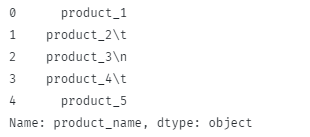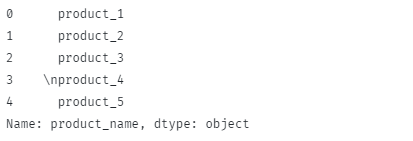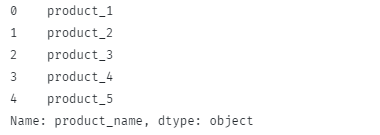Sample DataFrame
For illustration purposes, we will use the sample DataFrame shown below:
df = pd.DataFrame({
"product_name": [' product_1', 'product_2\t', 'product_3\n', '\nproduct_4\t', 'product_5'],
"price": [10.00, 20.50, 100.30, 500.25, 101.30]
})
The DataFrame above contains whitespace characters such as newline characters, spaces, and tabs.
Remove Leading Whitespace Characters
We can use the lstrip function to remove leading whitespace characters from a DataFrame column to remove leading whitespace characters from a DataFrame column as shown:
The lstrip function should remove the leading whitespace characters from the product_name column.
The code above should return:
Note that the leading space and new line whitespace characters are removed.
Remove Trailing Whitespace characters.
We can use the rstrip() function to remove trailing whitespace characters from a column.
An example is as shown:
Here, the code above should remove the trailing whitespace characters. An example return value is as shown:
Remove Both Leading and Trailing Whitespace Characters
Using the strip () function, you can also remove both the leading and trailing whitespace characters from a column using the strip() function.
An example usage is as shown:
In this case, the function should return:
Note how the leading and trailing whitespace characters are removed from the column.
Using Replace
You can also use the replace() function to remove whitespace characters from a column.
For example, to replace all tab characters from a column, we can do:
In this case, the function will take the tab characters and replace them with the specified value.
The resulting output is as shown:
To remove space and newline characters:
df.product_name.str.replace(' ', '') // remove spaces
Terminating
This article shows you various ways of removing leading and trailing whitespace characters from a Pandas DataFrame.




